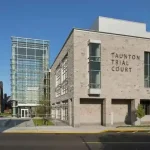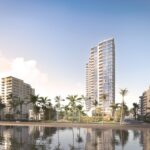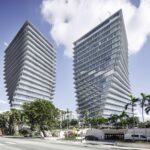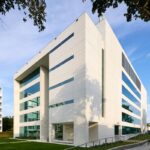Wilkie D. Ferguson Courthouse Miami, Florida Architecture Images, Architect, Photos
Wilkie D. Ferguson Jr. United States Federal Courthouse
Miami Court Development, Florida, USA, design by Arquitectonica + HOK
Jul 15, 2008
Wilkie D. Ferguson Jr. United States Federal Courthouse Miami
The Design
The Wilkie D. Ferguson Courthouse building stands at the end of the axis created by the 4th Street Promenade. However, because the center atrium space is approximately 20 meters above the plaza, both the physical and visual axes are maintained through the building. The Wilkie D. Ferguson Jr. Federal Courthouse design completes the judicial campus created by the old courthouse, the courthouse annex tower, the Lawrence King Building and the federal prison.
The planimetric design is based on a four-courtroom per floor layout. The two court towers are connected by a generous circulation lobby, which occurs on every floor, and rises dramatically throughout the entire height of the building. A dramatic conical glass atrium connects the floors by piercing through the lobbies and decreasing in size as it rises through the building terminating in a skylight.
The site plan is divided into two distinct zones. The first, at street level is comprised of densely planted native vegetation punctuated with seating and meandering walks which can be used for local art fairs and markets. The second zone is the lawn. It is raised approximately 1 meter above the sidewalk forming a natural and secure perimeter around the building.
The walls of the plinth have seating. The two east quadrants of lawn areas were designated as the sites in which the artist Maya Lin developed her earthen installation, “Flutter.” The hard-scape is primarily comprised of three-colored pre-cast pavers, which coordinate, with the pre-cast panels of the building.
The Wilkie D. Ferguson Jr. Federal Courthouse building is composed of three individual elements: the opposing two towers and the glass crystal that spans between them.
The east and west curtain-wall elevations of the two towers are a blueprint for the interior functions within the building. The alternating rhythms, depths and colors of the horizontal and vertical sunshades delineate the primary office, circulation, chamber and courtroom functions located in the tower.
The north and the south facades of the tower are solid pre-cast with punched openings reinforcing the solidity of the envelope which then create the asymmetrical frame on the east and west elevations.
The signage is located on all four elevations of the tower. At the base, it welcomes pedestrian, at the top it acts as a banner for the vehicular traveler. The exterior expression is primarily transparent and open reflecting the integrity of the court while emphasizing equality before the law.
A monumental three color stone colonnade recalling the richness of traditional courthouses supports the south tower. The north tower sits upon the building garage clad in stone columns placed at irregular intervals and a metal grille. The crystal curtain-wall spanning the two towers contains an atrium that pierces through each floor.
Stacking
The lower basement level of the Wilkie D. Ferguson Jr. Federal Courthouse contains two separate yet secure tunnels to the Courthouse Annex Tower. One for prisoner movement and the other for staff circulation.
The upper basement level contains a vehicular access to the south tower parking where there will be 16 secure spaces for the judiciary.
The building lobby is located at the south tower. Entry is from underneath the gateway, and in front of a multi color stone water feature of 40 m wide by 10.60 m high.
By passing through security the public is allowed into the main elevator lobby. The main lobby, where the Great Seal is located, and the elevator core are clad in a three color natural limestone. Escalators to jury assembly are located in the southern most tip of the south tower in an 18 m high space.
U.S. Marshal prisoner sally port, central plant, transformer vault, main electrical room, loading and GSA support are located on the plaza level of the north tower. Entry into secure parking is accessible from this level via ramp.
Main mechanical, electrical, maintenance and storage rooms are located in the ground level at the North Tower.
Parking in the north tower occurs on levels 2 to 4.
Mechanical room for the south tower is located on level 2 of the south tower.
Public defender is located on the 3rd floor
Jury Assembly is located on the 5th floor and is accessed directly by escalators located at the southern-most tip of the building.
The U.S. Marshal Service and central holding facility is located on the 6th floor. It is the first full floor that spans over the plaza and connects the two towers. The Marshals have direct access to both secure elevators on each side of the building, which link all the courtrooms above.
The Grand Jury and USAO are located on the 7th floor, while the Clerk of Court is split between the 7th and 8th floors. The cafeteria and servery are located in the 7th floor public space that spans across the Pedestrian Promenade and looks out over onto the judicial campus and the bay to the east.
Clerk of Court is located on the 8th floor.
U.S. Probation offices are located on the 9th Floor
The District Courtrooms, judicial chambers, jury rooms, holding cells and waiting areas are located on floors 10 to 12.
The 13th floor contains the two Special Proceedings courtrooms located in the north tower.
The judicial library and conference rooms and private dining are located on the 14th floor.
Air handlers for the courtrooms are located on mezzanine floors in between the courtrooms on levels 10 to 13.
Cooling towers, emergency generator and elevator machine rooms are located on the mechanical penthouse level.
Interior Finishes
The courtrooms are finished in a combination of wood veneer paneling, acoustical fabric wrapped panels and custom design glass in the walls. The ceiling is painted drywall in a custom designed “origami” shape. All millwork for the courtrooms, including the judge’s bench, clerk’s bench, jury box, witness stand, and gate are veneers of three different species of wood. Wood pew seating matches the walnut millwork.
All Judges’ benches are handicap adaptable. Jury boxes and witness stands are handicap accessible.
Carpet tile is used over raised floor areas in the courtrooms.
Judicial chambers consist primarily of wood paneling; fabric wrapped wall covering, wood base and carpet. A combination of drywall and acoustical lay-in tiles are used for ceiling treatment.
All courtroom public waiting areas and the main public lobby area receive drywall, wood panels, and limestone in three colors. Floors are in black calibrated slate to ensure durability and ease of maintenance.
Office space and jury deliberation rooms, attorney/client conference rooms have painted drywall, vinyl base on carpet with acoustical ceilings. Public restrooms with ceramic tile floors and walls and drywall ceilings.
Secure holding areas and all prisoner movement corridors are constructed in reinforced glazed ceramic tile in accordance to the U.S. Marshal’ design handbooks. Flooring in the secure areas is in epoxy terrazzo for ease of maintenance. Stainless steel, security acoustical ceiling system is used.
All mechanical, utility and electrical closets are constructed of painted CMU. Acoustical considerations are given to those areas that are extremely sensitive. This is achieved through wall treatment and sound attenuation.
Art-in-Architecture
Maya Lin was selected as the artist. Her work encompass the two east lawn quadrants of the building plaza. Each quadrant contains sculpted dunes and waves of earth and Bermuda grass reminiscent of the Florida coastline. The gentle dunes are approximately 3-4 feet high, ergonomically designed to allow children to play in them and adults to use them as seating areas. The dunes are deep enough to enhance the building’s perimeter security.
Highlights of the Design
The architect has fully designed a building that both meets the strict requirements of the United Sates Courts Design Guide and incorporates client, tenant and city requests, which include the following:
Natural light in all the courtrooms, chambers and jury rooms
Perimeter Security
Avoid relocation of underground utilities along NW 4th Street
Preservation of the 4th street promenade
Unified Landscape Design
Underground subway considerations
Dramatic interior space
Public Plaza/Community space
Tunnel connector
Building image and scale
30 year Expansion
The team achieved a significant reduction in the amount of impermeable surface area. Increase landscaping means less contaminated runoff into ecosystem.
Native and draught-tolerant plantings will conserve water and reduce maintenance. An efficient drip irrigation system will deliver water to plants with minimal evaporation.
The design goal is to provide 50 percent shading of glazed areas, which provides significant reduction in the cooling load.
The building envelope uses 9/16 inch laminated glazing for the curtain wall system and punched windows, which removes over 99 percent of ultraviolet (UV) radiation. Low-E glazing proved to be less effective; energy modeling showed that it trapped solar heat gain in the building.
Since microbial growth is the leading indoor contaminant, no internal insulation will be utilized for HVAC ductwork or sound attenuators. Commissioning before occupancy will also reduce the risk of microbe-related indoor air quality problems.
Materials include locally manufactured precast concrete; low-VOC paints, adhesives and finishes; low-toxicity waterproofing and damp-proofing compounds; and non-endangered wood species.
Specifications require construction waste recycling during demolition of existing television station on the site and during construction of the new facility.
Wilkie D. Ferguson Jr. Courthouse : main page
Location: Miami, Florida, United States of America
Miami Architecture
Contemporary Miami Architecture
Miami Architecture Designs – chronological list
Miami Architecture Walking Tours by e-architect : exclusive guided walks
Miami Architects Offices : Studio Listings
ilonabay, Miami Beach
Oppenheim Architecture + Design
Miami Beach condominium complex
Regalia – Condominium Tower, Collins Avenue, Sunny Isles Beach
Arquitectonica
Regalia Condominium Tower
Comments / photos for the Wilkie D. Ferguson Jr. United States Federal Courthouse page welcome
Website: Miami, Florida





